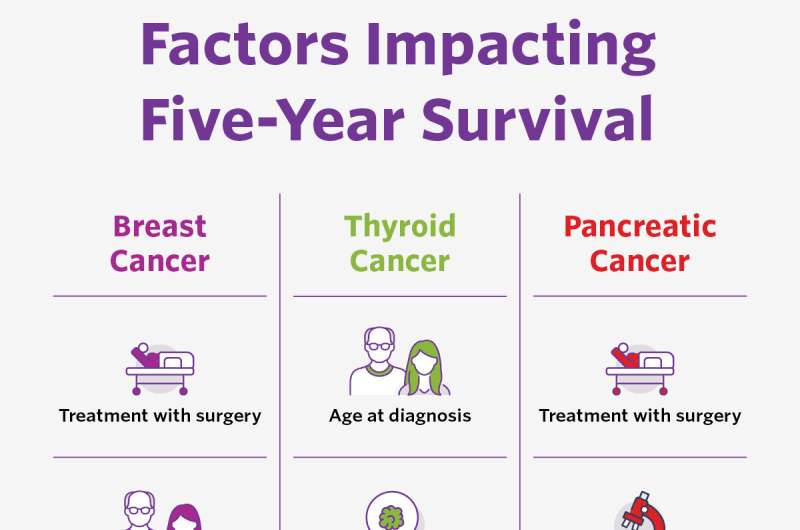This article has been reviewed according to Science X's editorial process and policies. Editors have highlighted the following attributes while ensuring the content's credibility:
fact-checked
trusted source
proofread
A cancer survival calculator is being developed using artificial intelligence

Researchers have developed an artificial intelligence (AI)–based tool for estimating a newly diagnosed cancer patient's chances for surviving long term, according to a study presented at the American College of Surgeons (ACS) Clinical Congress 2023.
Currently, estimating survival rates for patients with cancer primarily depends on their cancer stage, said lead study author Lauren Janczewski, MD, a clinical scholar with ACS Cancer Programs and a general surgical resident at Northwestern University McGaw Medical Center, Chicago.
"There is a multitude of other factors that may influence a patient's survival beyond just their staging criteria," Dr. Janczewski said. "We sought to develop this Cancer Survival Calculator to provide a more personalized estimate of what patients can expect regarding their cancer prognosis."
Using a type of AI known as machine learning, the multicenter research team created a prototype tool called the Cancer Survival Calculator and tested it on a nationwide cancer dataset. Initial tests estimated five-year survival for patients with cancers of the breast, thyroid, and pancreas.
Study details
According to Dr. Janczewski, this study aimed to identify the patient, tumor, and treatment characteristics that most greatly influence patient survival for each cancer type.
After cancer experts recommended characteristics to study, the researchers collected relevant information from patients diagnosed in 2015 and 2017 with breast, thyroid, and pancreatic cancers. The patients' records were part of the National Cancer Database (NCDB), which contains records of 72% of newly-diagnosed cancer cases in the United States.
Three-fourths of the collected data were used to train the machine learning algorithms to recognize patterns between characteristics at diagnosis and patients' survival at five years, and then to rank the factors with the greatest influence on survival. With the remaining data, the researchers used statistical methods to test the prototype's accuracy in estimating survival.
Key findings
The team included data from 259,485 breast cancer patients, 76,624 thyroid cancer patients, and 84,514 pancreatic cancer patients. The researchers found multiple characteristics specific to patients, tumors, and treatments for all three cancer sites significantly influenced survival.
The top four factors influencing whether patients were alive five years after diagnosis were as follows, by cancer site:
- Breast cancer: 1) whether the patient had cancer surgery, 2) the patient's age at diagnosis, 3) tumor size, and 4) time from diagnosis to treatment.
- Thyroid cancer: 1) age at diagnosis, 2) tumor size, 3) time to treatment, and 4) lymph node involvement.
- Pancreatic cancer: 1) cancer surgery; 2) histology, or microscopic analysis of the cancer, 3) tumor size, and 4) age at diagnosis.
Also found to be important for survival from breast cancer were hormone receptor status, which is part of breast cancer staging, and the presence of Ki-67, a biomarker in breast cancer.
Although some of the predictive factors, such as tumor size, are part of cancer staging, Dr. Janczewski said their results showed that many more factors influence survival for cancer patients beyond their disease stage.
Furthermore, their validation testing showed that the calculator was "highly accurate" for all three cancer sites at estimating cancer survival rates—within nine to 10 months of actual survival, Dr. Janczewski reported.
Advantages of the new calculator
The Cancer Survival Calculator differs in several ways from cancer survival estimators already in use, according to Dr. Janczewski:
- The novel calculator includes specific tumor biomarkers and treatment variables that are known to affect a patient's estimated prognosis, which Dr. Janczewski said many prior survival calculators lack.
- The dataset used to develop the new calculator, the NCDB, is more comprehensive than other calculators' datasets, according to Dr. Janczewski.
- The Cancer Survival Calculator uses new data modeling, such as machine learning, which speeds up processing. The models' risk predictions also demonstrated improved accuracy compared with predictions generated by older calculators, she said.
Future steps
The next steps that Dr. Janczewski identified are to finalize a user interface that will allow the use of the Cancer Survival Calculator in clinical practice, followed by pilot testing the calculator at selected cancer centers.
Eventually, the researchers hope to broaden the calculator by adding all other cancer sites included in the NCDB. Initially, the calculator included breast, thyroid, and pancreatic cancers because these cancers have diverse patient populations and differing frequencies and average survival rates, she said.
The research team plans to make the finalized informational tool available to health care practitioners.
Study co-authors are Joseph Cotler, Ph.D.; Bryan Palis, MA; Tanya Hoskin, MA; Courtney Day, MS; Ryan Merkow, MD, MS, FACS; Heidi Nelson, MD, FACS; Tracy Wang, MD, FACS; and Judy Boughey, MBBCh, FACS. Mayo Clinic and the Medical College of Wisconsin were study centers with Northwestern University.
More information: Janczewski L, et al. Development of a National Cancer Survival Calculator Prototype Using Machine Learning, Scientific Forum, American College of Surgeons (ACS) Clinical Congress 2023.



















